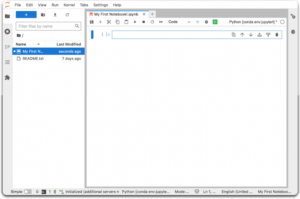Data science platform Anaconda has announced a new suite of products for its Nucleus online community, including a new data notebook and training portal.
Anaconda Notebooks is a cloud hosted, browser based JupyterLab instance that provides a ready-to-code Anaconda environment anywhere there is an internet connection. Features include 5GB of persistent storage, custom extensions, and access to a library with sample projects and notebooks.
The company also announced an on-demand training portal, Anaconda Learning, where it says users can access experts who will break down complex data science concepts into foundational instruction and micro coding challenges. The modular courses are self-paced and can be used with Anaconda Notebooks.

Anaconda Notebooks allows anyone, anywhere to begin their data science journey, the company says. Source: Anaconda
The new products are launching for members of Anaconda Nucleus, an online community focused on continuing education and sharing resources for Python users.
“As we continue to provide millions of people access to thousands of data science, AI, and machine learning packages, we asked ourselves, ‘How can we further expand access to data literacy and numerical computing? What can we do to further lower the barrier to entry?’” asked Anna Ng, Anaconda’s product marketing manager, in a blog. “Anaconda has been preparing the answer to that question for quite some time. Since the launch of our online community, Anaconda Nucleus, we have seen search terms like ‘Jupyter’ and ‘Python tutorial’ flood the platform as thousands of users look to get started. Finally, the day has come.”
Sample Anaconda Learning courses include an intro course, “Get Started with Anaconda,” that promises upon completion students will understand basic data science concepts and tools, how the different parts of the technology stack work together, five common Python packages and their uses, how to install Anaconda, and how to open and work with a Jupyter notebook or IDE, among other concepts.
Another course, “Introduction to Python Programming,” was designed to quickly teach users the foundations of Python. Students will learn how to read and write code, choose and use data structures, and recognize and resolve errors, according to the website. Anaconda says the ideal student for this would be someone who wants to learn how to code, to become a backend developer or data scientist, or a developer with experience in another programming language looking to branch out.

Anaconda says its new training portal allows students to code side-by-side with experts like Sophia Yang. Source: Anaconda
The platform also offers more advanced topics: “For those ready to dive in a little deeper, access our beginner-friendly courses on more advanced topics and learn from Anaconda’s resident Senior Data Scientist, Sophia Yang, as she breaks down how to approach, understand, and derive insights in her ‘Introduction to Data Visualization with Python’ course. Or join Thomas Nield, founder of the Nield Consulting Group and instructor at the University of Southern California, in his comprehensive ‘Introduction to Machine Learning’ course,” said Ng.
The company plans to periodically add more courses and says all data science methods taught through its platform are vetted, trusted, and battle tested by Anaconda.
The new products are rounding out a busy year for Anaconda. The platform surpassed a milestone of over 30 million global users, and its Python language has been named the world’s most popular programming language in the TIOBE Index for two years in a row, having ousted C and Java from the top spot for the first time in 20 years in 2021.
The company also recently acquired PythonAnywhere, a web-based Python development environment, on the heels of releasing PyScript, an open source framework for embedding Python applications in a web page that executes in a browser. These solutions aim to add flexibility and accessibility to coding with Python by allowing users to code on the desktop or the cloud while enabling both front-end and back-end development.
As building data science talent continues to be a focus for Anaconda, it appears the timing is apropos for the current talent environment. Last month, the company released its “2022 State of Data Science Report” that found 90% of professional respondents said their organizations are concerned about the current talent shortage, with 64% confiding they were most concerned about recruiting and retaining technical talent. Also, according to 56% of those surveyed, a large barrier to successful enterprise adoption of data science initiatives is the insufficient talent pool in the red-hot field.
“With data scientists continually cited as one of the best careers in the U.S., the pool of talent is sure to catch up to the demand,” said Jessica Reeves, SVP of Operations at Anaconda, in a release last month. “Solutions proving successful to help close this gap include upskilling existing workforces and permitting stronger remote work options. Organizations should bolster the tools and resources available for continued learning, and academic institutions should fill in the skills gaps for students and turn them into strengths as they prepare to enter the workforce.”
Related Items:
Security Concerns Causing Pullback in Open Source Data Science, Anaconda Warns
Anaconda Unveils PyScript, the ‘Minecraft for Software Development’
What’s Driving Python’s Massive Popularity?
The post Anaconda Unveils New Coding Notebooks and Training Portal appeared first on Datanami.

0 Commentaires